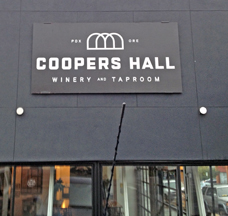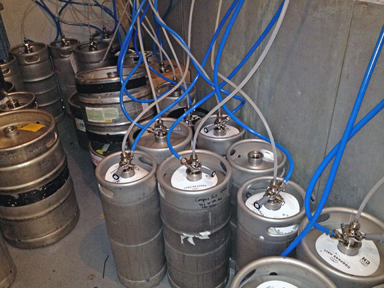 Portland, Oregon has one of the best food scenes in the country. Last evening we had dinner at Cooper Hall Winery & Taproom. Most of the building in the Central Eastside Industrial District is used for the winery including production area and space for barrels and tanks. At the time of our September visit, workers were finishing destemming red grapes. The destemmer/crusher is small and can be lifted and placed over a tank used for fermentation.
Portland, Oregon has one of the best food scenes in the country. Last evening we had dinner at Cooper Hall Winery & Taproom. Most of the building in the Central Eastside Industrial District is used for the winery including production area and space for barrels and tanks. At the time of our September visit, workers were finishing destemming red grapes. The destemmer/crusher is small and can be lifted and placed over a tank used for fermentation.
Adjacent to the winery production area, there is a sizable section used for a restaurant. In the restaurant section there is a bar and behind the bar there are dozens of taps for different wines.
Some of the wines are from Coopers Hall Winery. The winery sources fruit form Oregon, California and New Mexico. They have a selection of red and white wines. Also on tap are guest taps from mostly the United States but also a few from outside the US, sparkling wines and dessert wines. Behind the bar and taps, hoses from the taps lead to pressurized tanks that hold the wines.
Patrons can sample the wines in a two ounce pour, or buy the wine by the glass or carafe. I decided to try three wines by the two ounce pour, ideal if you want to taste the wines. A Cava caught my eye since we are headed to Spain to specifically taste Cavas. I tried the Torre Oria Cava Brut, an inexpensive Cava that is widely distributed. The yellow wine was served in a tasting glass resembling a smaller version of the O glass by Riedel. There were no bubbles present by the time the sparkling wine reached the table, although I perceived effervescence while in the mouth. Perhaps the restaurant lighting was too dark to perceive tiny bubbles, or the sparkling wine in the pressurized tank lost some of its fizz. The Cava was still good and offered apple, citrus and mineral notes.
I decided to try a Coopers Hall 2011 Pinot Noir Willamette Valley AVA. The translucent dark ruby colored wine ordered leather, raspberries and pepper with mild tannins. The wine had a medium-body and was crisp. It paired well with the Charcuterie Plate. For dessert I selected a Baltimore Rainwater from Portugal. This Madeira was a dark gold to orange color and had jammy cooked fruit characteristics. The wine had the typical oxidation associated with a Madeira.
The advantage of the wines on tap is the ability to taste a particular wine without opening a bottle. The disadvantage is that customers have no labels to view. Perhaps the restaurant could create bottle shots and print them or place them on an iPad and online. Customers could then look at the labels for whatever they want to gather from the label such as alcohol level and grapes used in the wine if that was not obvious.
Cheers,
Terry
-1.5in.jpg)



